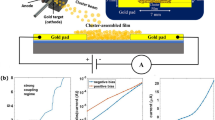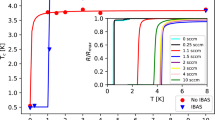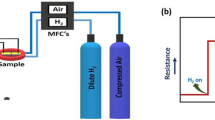Abstract
WE report a method for obtaining highly conducting films of noble metals between 11 and 50 Å thick on mica substrates. At the lower limit, the ultra-thin film (11 Å) may consist only of two or three monolayers each of gold and platinum. The minimum thickness at which pure gold films start to conduct is known to be 30 Å (ref. 1). Before this we had found that a pre-nucleating layer of silver, 5 to 7 Å thick, on mica yielded a highly conducting gold overlayer above a total (Au + Ag) thickness of about 32 Å (ref. 2). It was concluded that nucleating layers of suitable materials, of a thickness below which island formation commences, might lead to a higher conductivity in films of total thickness less than 50 Å. In this range, irregularities in the surface of the substrate, for example cleavage steps, become comparable to, or even greater than the film thickness. Cleaved mica surfaces are known to have hill-and-valley type microstructure. The cleavage step heights are about 20 Å or integer multiples thereof3. As film thickness decreases to these values, d.c. measurements of conductivity become progressively less accurate. To alleviate this difficulty, we have measured microwave sheet resistance (Rμ in Ω per square) at 9.7 GHz by Slater's method4. The corresponding wavelength is more than six orders of magnitude greater than any irregularity in the surface of the mica. We have used this method previously to estimate the conductivity of gold films thicker than 50 Å (ref. 5).
This is a preview of subscription content, access via your institution
Access options
Subscribe to this journal
Receive 51 print issues and online access
$199.00 per year
only $3.90 per issue
Buy this article
- Purchase on Springer Link
- Instant access to full article PDF
Prices may be subject to local taxes which are calculated during checkout
Similar content being viewed by others
References
Cornely, R., and Fuschill, N., Bull. Am. phys. Soc., 18(1) 16 (1973).
Chaurasia, H. K., thesis, Univ. British Columbia, Vancouver Canada (1964).
Tolansky, S., in Microstructure of Surfaces using Interferometry, 15 (American Elsevier, New York, 1968).
Slater, J. C., in Microwave Electronics, 30 (Van Nostrand, New York, 1950).
Chaurasia, H. K., and Voss, W. A. G., IEEE Trans. Microwave Theory Tech., MTT-21(1), 51 (1973).
Lepselter, M. P., Bell System tech. J., 45, 233 (1966).
Novak, W. B., and Dyre, R. N., J. Vac. Sci. Technol., 9(1), 279 (1972).
Glang, R., in Handbook of Thin Film Technology, 1–34, (edit. by Maissel, L. I., and Glang, R.) (McGraw-Hill, New York, 1970).
Niedermeyer, R., and Hillecke, D., in Ultra Micro Weight Determination in Controlled Environment, 213 (edit. by Wolsky, S. P., and Zdanuk, E. J.), (Wiley-Interscience, New York, 1969).
Warner, A. W., in Ultra Micro Weight Determination in Controlled Environment (edit. by Wolsky, S. P., and Zdanuk, E. J.), 154 (Wiley-Interscience, New York, 1969).
Yang, L., Birchenall, C. E., Pound, G. M., and Simmond, M. J., Acta. Metall., 2, 462 (1954).
Poppa, H., Moorhead, R. D., and Heinemann, K., Nucl. Instrum. Meth., 102, 521 (1972).
Author information
Authors and Affiliations
Rights and permissions
About this article
Cite this article
CHAURASIA, H., Voss, W. Ultra-thin conducting films of gold on platinum nucleating layers. Nature 249, 28–29 (1974). https://doi.org/10.1038/249028a0
Received:
Revised:
Issue Date:
DOI: https://doi.org/10.1038/249028a0
This article is cited by
-
Transparent conductive electrodes for electrochromic devices: A review
Applied Physics A Solids and Surfaces (1993)
Comments
By submitting a comment you agree to abide by our Terms and Community Guidelines. If you find something abusive or that does not comply with our terms or guidelines please flag it as inappropriate.



